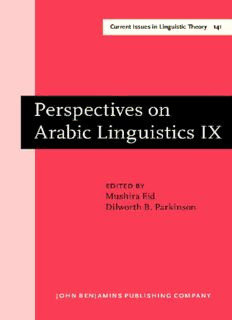
Perspectives on Arabic Linguistics: Papers from the Annual Symposium on Arabic Linguistics. Volume IX: Washington D.C., 1995 PDF
Preview Perspectives on Arabic Linguistics: Papers from the Annual Symposium on Arabic Linguistics. Volume IX: Washington D.C., 1995
PERSPECTIVES ON ARABIC LINGUISTICS IX AMSTERDAM STUDIES IN THE THEORY AND HISTORY OF LINGUISTIC SCIENCE General Editor E.F. KONRAD KOERNER (University of Ottawa) Series IV - CURRENT ISSUES IN LINGUISTIC THEORY Advisory Editorial Board Henning Andersen (Los Angeles); Raimo Anttila (Los Angeles) Thomas V. Gamkrelidze (Tbilisi); John E. Joseph (Hong Kong) Hans-Heinrich Lieb (Berlin); Ernst Pulgram (Ann Arbor, Mich.) E. Wyn Roberts (Vancouver, B.C.); Danny Steinberg (Tokyo) Volume 141 Mushira Eid and Dilworth Parkinson (eds) Perspectives on Arabic Linguistics IX PERSPECTIVES ON ARABIC LINGUISTICS IX PAPERS FROM THE NINTH ANNUAL SYMPOSIUM ON ARABIC LINGUISTICS Edited by MUSHIRA EID The University of Utah, Salt Lake City DILWORTH PARKINSON Brigham Young University, Provo JOHN BENJAMINS PUBLISHING COMPANY AMSTERDAM/PHILADELPHIA The paper used in this publication meets the minimum requirements of American National Standard for Information Sciences — Permanence of Paper for Printed Library Materials, ANSI Z39.48-1984. Mushira Eid and Dilworth Parkinson (eds) Perspectives on Arabic Linguistics IX Amsterdam studies in the theory and history of linguistic science. Series IV, Current issues in linguistic theory, ISSN 0304-0763 ; v. 141) ISBN 90 272 3645 3 (Eur.) / 1-55619-596-6 (US) (alk. paper) © Copyright 1996 - John Benjamins B.V. No part of this book may be reproduced in any form, by print, photoprint, microfilm, or any other means, without written permission from the publisher. John Benjamins Publishing Co. · P.O.Box 75577 · 1070 AN Amsterdam · The Netherlands John Benjamins North America · P.O.Box 27519 · Philadelphia PA 19118-0519 · USA Table of Contents Foreword vii Introduction 1 L Codeswitching with Arabic Arabic and Constraints on Codeswitching 9 Carol Myers-Scotton, Janice L. Jake, & Maha Okasha Embedding Verbs and Collocations in Moroccan Arabic/Dutch 45 Codeswitching Louis Boumans Codeswitching, Code-mixing, and Borrowing in the Spoken Arabic of a Theatrical Community in Cairo 69 David Wilmsen II. Grammatical Perspectives Implicational Dialectology: Second person pronouns and suffixes in Tunisian Arabic 95 Michael Gibson Clitic Left Dislocation in Moroccan Arabic 115 Latta Lalami Accessing Pharyngeal Place in Palestinian Arabic 131 Kimary N. Shahin The Derivation of the Imperative in Arabic 151 E labbas Benmamoun ΠΙ. The Acquisition of Arabic Resetting Parameters in Acquiring Arabic 167 Naomi Bolotin Ellipsis as a Mirror of Case and Agreement Principles in Language Acquisition 179 Lamya Abdulkarim IV. Negation in Arabic The Negation maašii in a Yaafi'i Dialect (Yemen) 195 Martine Vanhove Negation in Some Arabic Dialects of the Tihaamah of the Yemen 207 Marie-Claude Simeone-Senelle ma-ti'raf xeeri: Verbal negation in Egyptian and Moroccan Arabic proverbs 223 Elizabeth M. Bergman Index of Subjects 247 FOREWORD On March 10-12, 1995, the Ninth Annual Symposium on Arabic Linguistics was held at Georgetown University, Washington, D.C. The symposium was sponsored by the Arabic Linguistics Society, Georgetown University's School of Languages and Linguistics and its Department of Arabic, and the University of Utah. A total of sixteen papers were presented at the symposium; of these, nine are published in this volume. The papers presented at the symposium were selected on the basis of an anonymous review of abstracts submitted to the Program Committee. The papers included in the volume were further reviewed by the editors before their final acceptance for publication. In addition, a workshop was organized for the first time with the purpose of presenting data on a particular topic. The topic for the ninth symposium was negation in Arabic. Six papers were presented at the conference; of these, three are published in this volume. The transcription of all Arabic materials in the body of the papers follows the International Phonetic Alphabet or standard equivalents. The Arabic emphatics, however, are represented by a dot underneath the symbol, and long vowels as sequences of two vowels. The transliteration of Arabic names and titles follows accepted formats, with some simplification in the use of diacritics. We have used ' and ' for hamza (glottal stop) and 'ayn (pharyngeal approximant), respectively. The preparation and printing of the final manuscript was done using facilities available at the Middle East Center of the University of Utah, Salt Lake City. I am indebted to Tessa Hauglid, who has served as assistant editor as well as copy editor for this volume. I also thank Karin Ryding for organizing the symposium at Georgetown University. INTRODUCTION MUSHIRA EID University of Utah DILWORTH PARKINSON Brigham Young University The study of codeswitching has been the topic of many recent linguistic investigations into the nature and purpose of this behavior. It has been approached from a variety of perspectives, depending on the background and linguistic orientation of the investigator. Intrasentential codeswitching, or the alternating use of more than one variety of language within the same sentence, has received more attention lately because of the potential it has for showing how linguistic conflicts may be resolved when two or more systems interact within the speech of an individual or a community of speakers. The three papers in Section I of this volume address this aspect of codeswitching. The first two papers deal with bilingual codeswitching, whereas the third deals with codeswitching between varieties of Arabic (colloquial and standard). The first paper, by Carol Myers-Scotton, Janice Jake, and Maha Okasha—based on the keynote address presented at the symposium— examines codeswitching data involving Arabic and three other languages (English, French, Dutch). Using the Matrix Language Frame model, they propose to illustrate the explanatory value of this model by focusing on the analysis of Pronoun Doubling in codeswitching with Arabic: the doubling of the subject pronoun such that the first pronoun is always from Arabic. Their analysis is based on a distinction between matrix and embedded language. The matrix language, for example, sets the grammatical frame in mixed
Description: